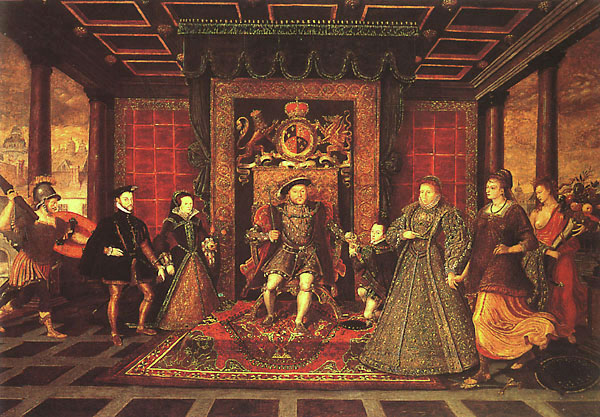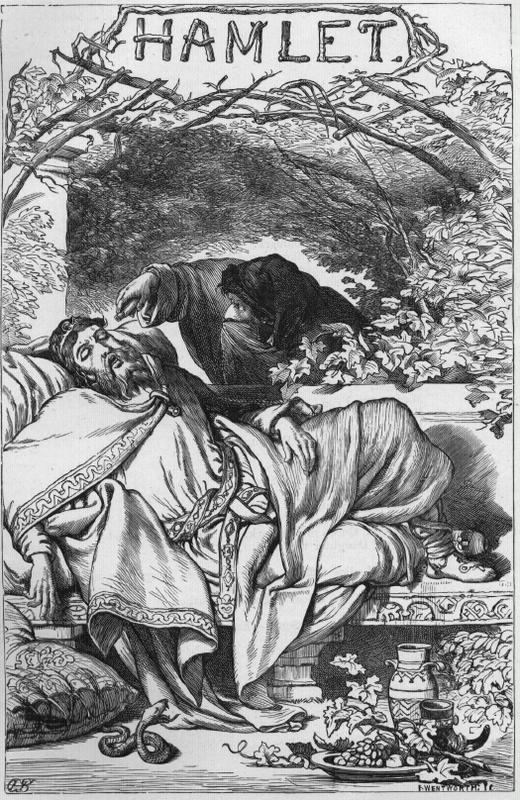Any modern production of Hamlet needs to navigate three separate rules of succession. The way we, especially as Americans, imagine the laws of succession today differs greatly from the Elizabethan view, which is itself removed from the rules of the story's Danish origin.
21st Century America
We are used to the idea of a hereditary lineage, where the eldest child becomes the next monarch. In our cultural memory of “once upon a time,” it is the eldest male child that would take the throne. However, our concepts of “once upon a time” are typically that of the Grimm brothers (Cinderella, Snow White, Red Riding Hood, etc.), Irving (Rip van Winkle, Sleepy Hollow), or Alexandre Dumas (The Three Musketeers). When we think back further, we imagine the medieval world as depicted by Malory (Le Morte d' Arthur), Tennyson (Idylls of the King), or the Robin Hood legends (collected and popularized by Francis Child). While the source material for these tales might date centuries earlier, all of these authors were writing in the past 250 years. The United States predates most of these texts, as does the end of French royalty. Since then in British and other familiar monarchies, it has been the eldest heir who has been crowned. The idea has become so ingrained that today when we think of succession, we first think that the eldest child must inherit the throne.
 |
| Simple, right? |
It can be difficult, then, for the modern audience to imagine the rules regarding succession in Hamlet's Elsinore, yet these rules provide the roots of the succession in Shakespeare's Hamlet. The principal source is Saxo Grammaticus's Life of Amleth, written around 1185 as part of his Gesto Danorum (a heroic history of the Danes). This tale is likely written down from a much older oral tradition. Isaac Asimov, in his wonderful Guide to Shakespeare, estimates the story taking place about 1050, well in the realm of “once upon a time” for Saxo Grammaticus. It is a Danish tale, set in Viking times in Viking lands, and is more culturally kin to Beowulf than to Othello. Rather than imagining the original Danes of Elsinore living in drafty stone castles, wearing doublets, robes, or shiny plate armor, we might more accurately picture them in mead halls wearing tunics or chain mail.
 |
| Hamlet going to England? |
 But it was also likely that the late king's brother, uncle, or younger child might succeed as ruler. By these rules, Prince William (or Harry) might succeed Queen Elizabeth, if he was thought to have more leadership potential, rather than her son Charles.
But it was also likely that the late king's brother, uncle, or younger child might succeed as ruler. By these rules, Prince William (or Harry) might succeed Queen Elizabeth, if he was thought to have more leadership potential, rather than her son Charles. Less common ways to a throne include popular demand or military might, securing a crown by overwhelming popular consent or physical prowess. These are all claims to the throne we see in Hamlet. Hamlet is the son who is passed over in favor of the king's brother Claudius. Laertes and Fortinbras have more tenuous claims: Laertes leads an uprising of Danes, and Fortinbras enters commanding an invading army.
17th Century England
Shakespeare's Hamlet was written about 1600, halfway between Saxo Grammaticus' writing and now. The then-400-year-old Danish tale must have had a “long ago and far away” sensibility to it, which was not entirely abandoned in Shakespeare's re-working of the story. Additionally, the Danish succession laws that must have pushed the bounds for Elizabethan idea of “once upon a time” were given a new perspective in light of recent English history. The Tudors, of which Queen Elizabeth was the last, gave England five monarchs in three generations. Who was fit to rule, and how these decisions were made, were popular themes in Shakespeare's plays, and could not have been very far from the public consciousness. Shakespeare's histories depict the turnover of succession in previous generations, dating as far back as King John (reigning 1199-1216), and as recent as Henry VIII, the Queen's father.
 |
| Henry VIII family portrait |
The Elizabethans would have recognized Claudius' claim to the throne over Hamlet's as archaic, but it would not have seemed as shocking as it seems to us. Asimov points out that Hamlet's primary concern with the succession is not that Claudius succeeded Hamlet Sr., but the speed at which the decision was made (presumably before Hamlet could get from Wittenburg to Elsinore and nominate himself for the position).
 |
Our production is not governed by the 1584 Act, but by modern laws and media coverage. Claudius's murder of Hamlet Sr. is justified, but still kept quiet, since murder is a capital offense, and even the whisper of suspicion in the media could bring down his reign. Indeed, in Hamlet: Reframed, there is not the whisper of Claudius's act, since the court had no suspicion of the deed. Even when Hamlet “outs” Claudius by performing 'The Mousetrap,' the murder lurks, at most, just below the surface.
Our 21st Century Elsinore
 |
| Claudius (John Stange) |
Therefore, instead of letting modern sensibilities fight both Shakespeare's text and its source material, we shifted the world so that the succession laws are not familiar to a modern audience. Despite setting Hamlet: Reframed in the present, we have gone back to the source material to inform the succession in Denmark. For example, in Saxo Grammaticus' telling, it is Gertrude whose father was king, not Hamlet Sr. Nowhere in Shakespeare's play is there evidence that the bard altered this lineage, but neither is it explicit. In Hamlet: Reframed, we have chosen to preserve Gertrude's royal blood. Therefore, it falls on Gertrude to name Hamlet Sr's successor. Hamlet was not 'passed by' in an illegal sense, but both the abruptness of Claudius's coronation and Hamlet's own sense of entitlement give him cause to loathe the decision and distrust those it benefits.
In modernizing the world of Hamlet, we nevertheless made several choices that put Hamlet: Reframed closer to its Danish source, and let them play out today. It is our hope that many of these choices are new to today's audiences, and assist in reframing the familiar story.


No comments:
Post a Comment